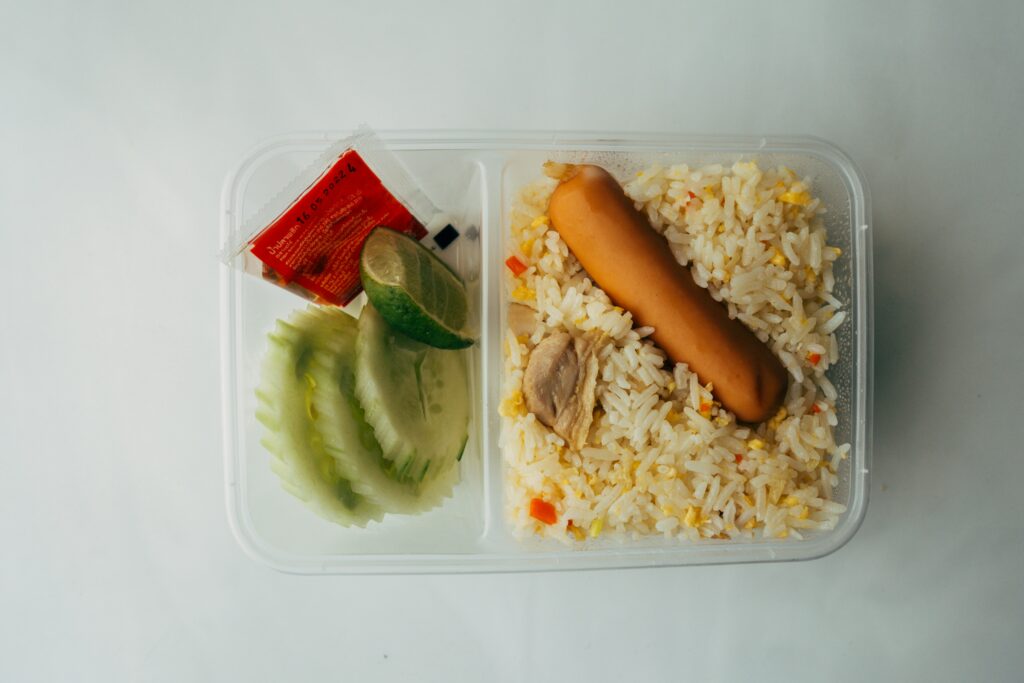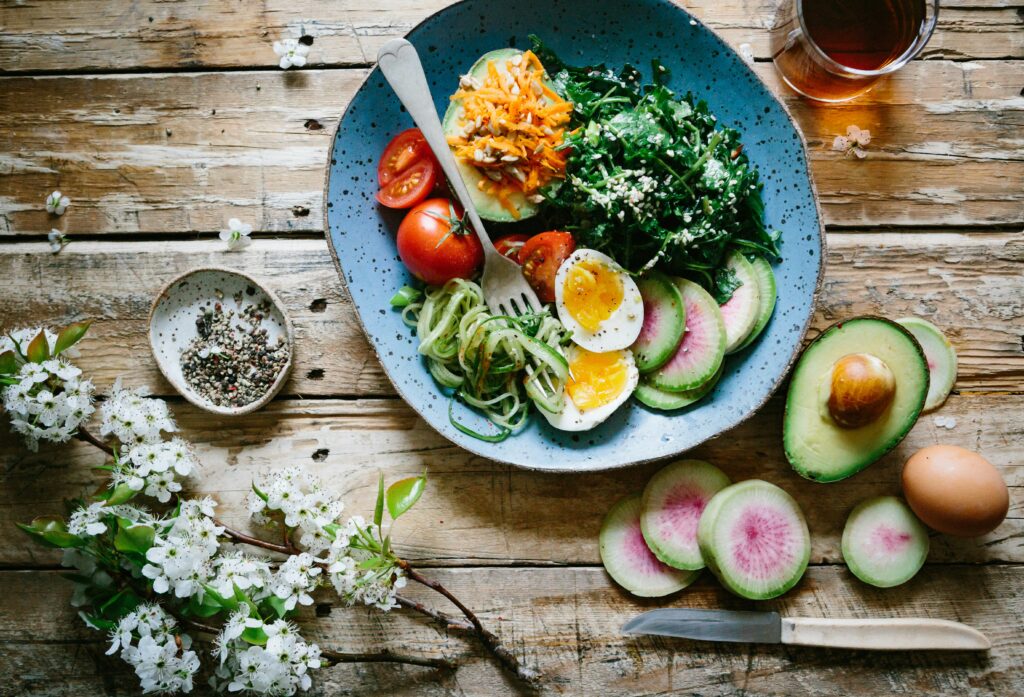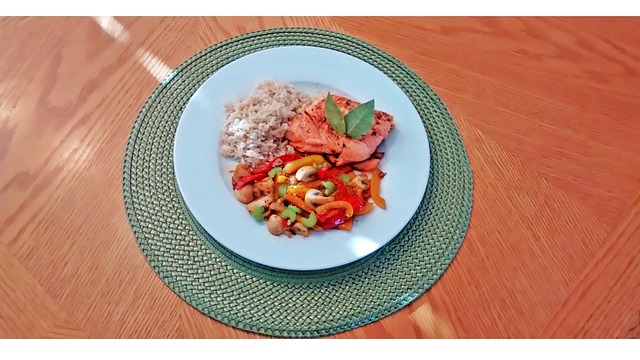Why Meal Planning Beats Last-Minute Eating
Planning your meals ahead of time does more than remove stress—it builds a foundation for healthier, more consistent living. Here’s why taking a few minutes to plan your week is a better strategy than winging it at dinnertime:
Save Time, Money, and Mental Energy
- No more daily debates over what to eat
- Fewer trips to the grocery store
- Avoid waste by buying only what you need
- Budget-friendly: prevents impulse purchases and unnecessary takeout
Create Consistency in Healthy Habits
- Regular meals help regulate blood sugar levels and energy
- More likely to follow through with nutritious choices when they’re already prepared
- Builds long-term routines that support your goals whether it’s weight loss, energy, or general wellness
Cut Out Processed Picks and Impulsive Eating
- You won’t have to rely on emergency snacks or fast food
- Meal planning steers you toward whole, nutrient-dense foods
- Avoids the “I’ll figure it out later” trap that usually ends with empty calories
Taking control of your weekly meals reduces stress and increases your chances of actually hitting your health goals. It’s less decision fatigue, more prepared confidence.
Step 1: Get Clear on Your Nutritional Goals
Before you make a grocery list or preheat the oven, figure out what you’re actually aiming for. Your meal plan should match your goals—whether that’s shedding some weight, building strength, staying steady, or just not crashing by 2 PM.
Start with calories. You don’t need to obsess, but having a ballpark number helps. Plenty of free tools online can estimate your baseline needs based on age, weight, activity level, and goals. Want to drop fat? Eat slightly below maintenance. Trying to gain muscle? Aim for a small surplus and back it with strength training. Maintenance or energy balance? Keep things steady, focus on balance and quality.
Next comes your macros—protein, fats, and carbs. They’re the fuel mix for your engine. Protein builds and repairs, fats support hormones and brain health, carbs give you quick and steady energy. A solid starting point: 30% protein, 30% fat, 40% carbs. Tweak from there based on how you feel and perform.
This step doesn’t need to be complicated. It just needs to be intentional. Know what you’re fueling—and fuel for that purpose.
(Read next: Understanding Macros and Their Role in a Healthy Diet)
Step 2: Outline Your Weekly Schedule
Creating a meal plan without accounting for your weekly rhythm is like packing for a trip without checking the weather. Your schedule shapes how much you can realistically prep, cook, or eat at home. Flexibility and awareness are key.
Start by Mapping Out Your Week
Ask yourself:
- Which days are packed with meetings, commutes, or activities?
- When do you have more time to cook or experiment?
- Do you often work late or skip meals on certain days?
This highlights when you’ll need grab-and-go meals versus when you might have time for fresher or more elaborate options.
Consider Real-Life Meal Interruptions
No week goes exactly to plan, so build in room for life’s curveballs:
- Dining out: Whether it’s social plans or business lunches, make space in your plan so you’re not overbuying groceries.
- Leftovers: Intentionally cook larger portions a couple of times per week. This gives you ready-to-eat meals for your busiest days.
- Skipped meals: If there are days where breakfast or lunch tends to get pushed aside, plan accordingly with nutrient-dense snacks or smoothies.
Make Your Plan Work for You
Meal planning isn’t a rigid rulebook—it’s a flexible framework that evolves with your schedule.
- Match meals to your energy and availability.
- Don’t aim for an ideal week. Aim for your real week.
- Over time, you’ll notice patterns that help simplify future planning.
Step 3: Build a Balanced Framework
Creating a healthy meal plan doesn’t mean eating the same thing every day—it’s about building a flexible structure that supports your goals and keeps things simple.
Daily Meal Structure
Start with a basic plan for the day. This helps eliminate decision fatigue and ensures you’re fueling your body consistently.
- Breakfast: Set the tone with protein, healthy fats, and slow-digesting carbs (e.g., eggs with oats, Greek yogurt with fruit and seeds).
- Lunch: Aim for a balanced plate—lean protein, colorful veggies, and a fiber-rich carb like quinoa or sweet potato.
- Dinner: Keep it light but satisfying (e.g., grilled chicken or tofu with roasted vegetables and brown rice).
- Snacks: Choose nutrient-dense options like nuts, sliced veggies with hummus, or a smoothie to bridge meals.
Focus on Whole Foods
Prioritize ingredients that are minimally processed and packed with nutrients. This keeps your energy steady and supports long-term health.
- Lean Proteins: Chicken breast, fish, legumes, tofu, eggs
- Complex Carbohydrates: Quinoa, brown rice, oats, sweet potatoes
- Healthy Fats: Olive oil, avocados, nuts, seeds
Add Variety to Your Week
Eating the same meal every day is a fast track to burnout. A little variety can go a long way in keeping your plan sustainable.
- Rotate different proteins through the week (e.g., salmon one night, lentils the next)
- Mix up your seasonings and sauces to avoid flavor fatigue
- Try themed nights (e.g., taco Tuesday, stir-fry Thursday) to simplify decisions
A structure that includes flexibility, whole ingredients, and rotating meals makes meal planning both healthy and enjoyable.
Step 4: Choose 2–3 Go-To Recipes per Meal
Keep it simple. You don’t need a new recipe every day of the week. Pick two or three go-to meals for breakfast, lunch, and dinner—ones you actually enjoy and can cook with your eyes half-closed. Rotating your favorites keeps decision fatigue low and planning quicker. Variety can wait for weekends or when you’ve got space to experiment.
Aim for recipes that hold up over time. Think chili, stir-fries, sheet-pan dinners, overnight oats—foods that can live in the fridge for a few days without turning on you. Double up when cooking and stash extras for midweek sanity.
And yes, freezer meals matter. They’re your emergency parachute. Soup, curry, protein muffins—anything you can batch and freeze is a future win. Cooking in bulk might feel heavy upfront, but it’s light work when the alternative is eating random snacks for dinner.
Make your rotation tight. Make it work for your real life.
Step 5: Build Your Grocery List with Intention
Grocery shopping doesn’t need to feel like a slow march through chaos. Start with one solid trip. One list. One route through the store. Pick a day, check your plan, and buy everything at once. It keeps meals on track, saves fuel, and cuts back on those midweek emergency snack runs.
When you’re scanning labels, don’t get distracted by buzzwords like “natural” or “keto-friendly.” Flip the package over. Fewer ingredients, words you recognize, and no mystery fillers? Good. Added sugars and seed oils hiding in the ingredient list? Maybe not so good. You’re looking for whole, simple fuel—not marketing fluff.
Last, organize your list by how you walk the store. Group by produce, protein, pantry, dairy. That five seconds of planning can save you twenty minutes of doubling back. Efficiency here pays off big, especially when your plan means hitting the kitchen right after you unload.
Plan smart. Shop once. Stick the landing.
Step 6: Prep Smart, Not Complicated
Think of meal prep like setting up dominoes. A bit of time on the front end saves you from scrambling all week. Start with the basics: chop your veggies now so you don’t have to think twice midweek. Toss onions, peppers, carrots—whatever you’re using—into sealable containers so they’re ready to go. It’s a small step that speeds up every meal.
Next, bulk-cook proteins and grains. Grill or roast a few chicken breasts, bake tofu, boil quinoa or rice—anything that forms the base of multiple meals. These staples can be repurposed into wraps, bowls, salads, and more with minimal effort.
Finally, portion things out. Use containers that fit your actual serving sizes. When you’re tired, the last thing you want is to guess or prep from scratch. Having meals that are ready to grab and heat means you’re way less likely to order takeout. Meal prep doesn’t need to be a hashtag—just a habit.
Extra Tips for Sustainability
The most effective meal plans aren’t rigid—they bend with real life. Some weeks you’ll be on top of it. Other times, dinner gets skipped, leftovers pile up, or you just don’t feel like cooking. That’s not failure, that’s being human. Design your plan with wiggle room. Swapping meals within the week or skipping a recipe entirely is fine. The goal is sustained progress, not perfection.
Keep a couple of lazy backups in your back pocket. Think: a quick omelet with spinach, a salad bowl with whatever’s in the crisper, a smoothie with frozen fruit and protein powder. These aren’t cheats—they’re smart fallbacks that take five minutes max.
Finally, pay attention to how your plan makes you feel. Are you dragging by 3 p.m.? Bloating after lunch? Are your cravings under control, or are you raiding the pantry at night? Tracking your energy, mood, and digestion helps you tweak your meals to fit your body’s feedback—which is what this whole thing is really about.
Conclusion: Make Meal Planning a Ritual, Not a Chore
Set aside one time each week—Sunday evening, Friday morning, whenever works. Just once. Get your plan roughed out, not perfect. The point isn’t flawless execution. It’s knowing ahead of time what’s going in your body and why, even if the week goes sideways.
You’ll adjust as you go. The first week might be too ambitious or too bland. Doesn’t matter. It’s data. You learn, tweak, and keep building. That’s where real control comes from—not strict rules, but repetition with intention.
Start small. One planned meal a day, then two. Maybe just dinners for now. Keep showing up, and over time, the process turns into autopilot. You’re not just eating better. You’re saving mental energy and reclaiming time. It builds. Quietly and consistently.


 Charles brings his sharp eye for detail and love of global cuisine to FoodHypeSaga. His writing dives into food culture, exploring fresh trends and unique flavors with a modern perspective.
Charles brings his sharp eye for detail and love of global cuisine to FoodHypeSaga. His writing dives into food culture, exploring fresh trends and unique flavors with a modern perspective.

